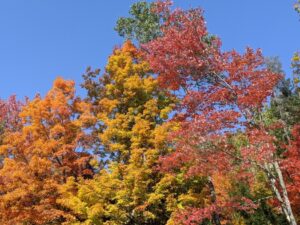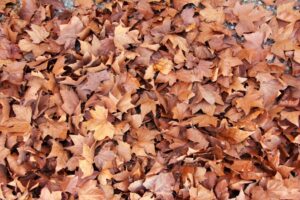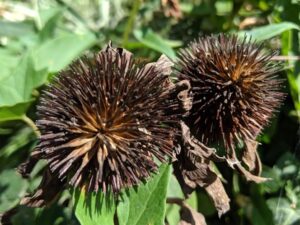
The beautiful fall season is upon us, when nature starts winding down in preparation for the winter. This is the perfect time to go over fall maintenance of your garden to benefit nature and the surrounding ecosystem. Unlike traditional gardens where aesthetics are prioritized, central to the habitat garden is its connection to a wider ecological web and the value it provides to the surrounding environment in the form of biodiversity, carbon capture, pollination, food for wildlife, cover and protection, seed dispersal, and nesting sites. Your thoughtful care of the garden at this time of year will help nature do what it does best.
Leave the leaves
It’s best to leave the leaves intact in your garden beds as this is overwintering habitat for many species including insects, toads, salamanders, moths, and butterflies. Birds forage for food in the leaves as well. Some caterpillars will even roll themselves inside the leaves for shelter.
Mulch leaves over lawn areas

Instead of raking, blowing, bagging, and hauling leaves away, just mulch them in place on your lawn. It’s free organic material for your lawn and a lot less work. Leaves left to decompose on the grass release inorganic compounds like nitrogen and phosphorus that make for a healthy soil. Not every mower has the correct mulching blades to mulch leaves, and you may need to get a mulch kit to retrofit your mower.
Set up a brush pile
Rather than hauling dead branches and debris off-site, create a brush pile out of sight somewhere in your yard. This brush pile will shelter birds and small mammals in the winter from predators and harsh weather. Lay down large trunks and logs first to create the foundation of the pile. Build up the pile in layers with branches and debris, but don’t pack it too tightly and allow some pockets and spaces to create ideal overwintering shelter habitat.
Leave grasses standing
Many insects and native bees crawl inside the hollow stems of plants, to hunker down through the winter so leave your tall grasses standing. In fact, 15 percent of bee species in North America nest in cavities, like hollow stems and holes in wood.
Don’t cutback flower heads

The seeds from coneflowers, black-eyed Susans, and many of our native wildflowers are eaten by birds all winter long. Rather than the tidy urge to cut back perennials to the ground, leave the stems and flowerheads attached and standing; this is nature’s winter birdfeeder, no need to buy bags of seed from the store!
Overseed the lawn with clover
Clover is bee food – it starts blooming early, around April or May when not much other pollinator food is around. The fall is a good time to seed clover, when the temperature remains at or above 40 degrees. I recommend aerating the lawn first if you can (you may have to rent a machine from the hardware store), then over-seeding with clover. You can use a simple Dutch white clover mix. Mix the clover seed with sand or a fine soil and use a spreader to spread the seed more evenly. If it doesn’t rain, water daily for at least 2 weeks. The most important tip is to enjoy the fall color show!
Amanda Bayley is the CEO & Co-Founder of Plan it Wild, a sustainable land management company that is bringing back native habitats to Westchester yards. More Nature. Now. www.PLANitWILD.com








Do grass clippings work as well as leaves in the garden?
Wonderful article, very informative. Thanks for sharing your knowledge with us.
Nancy